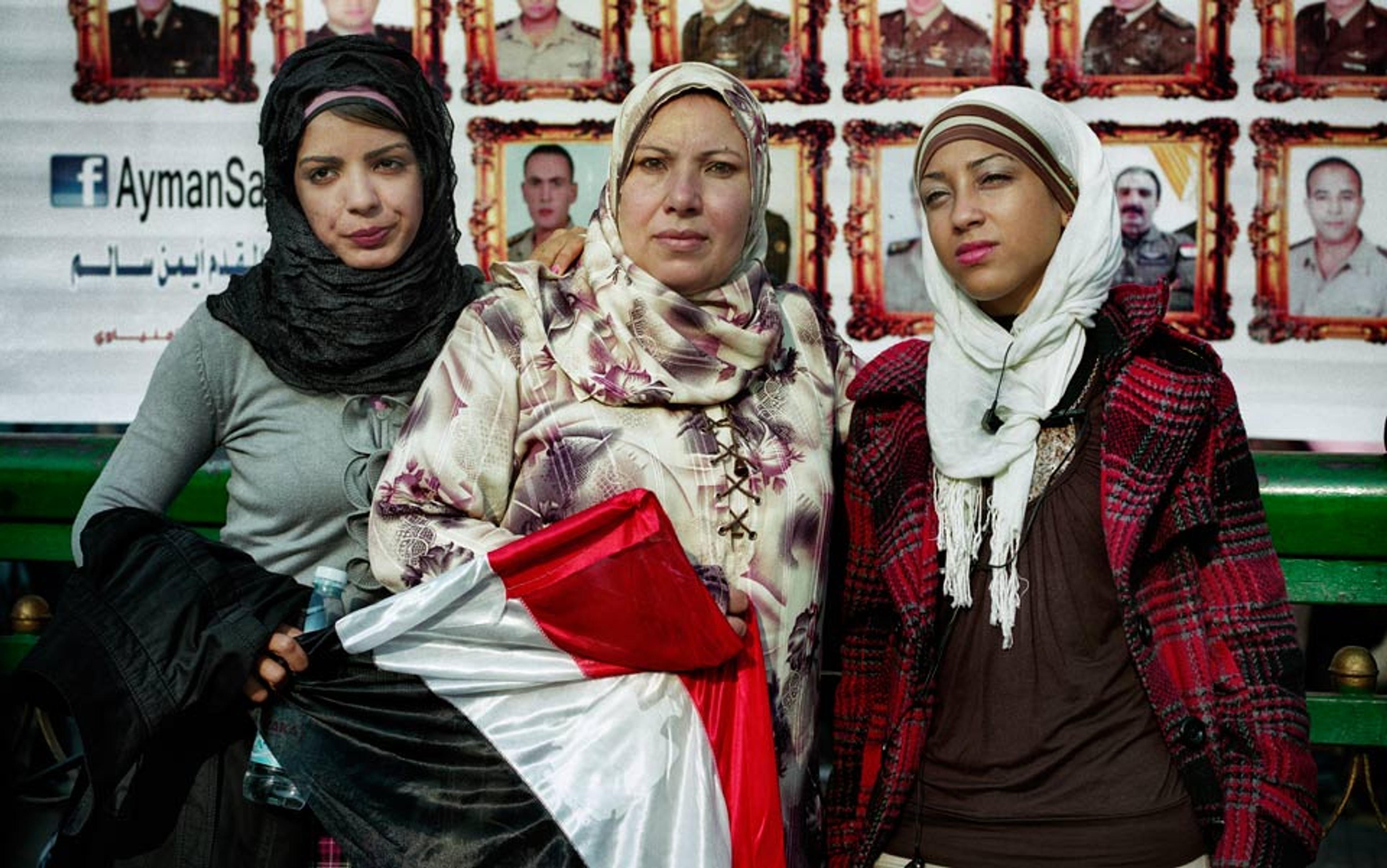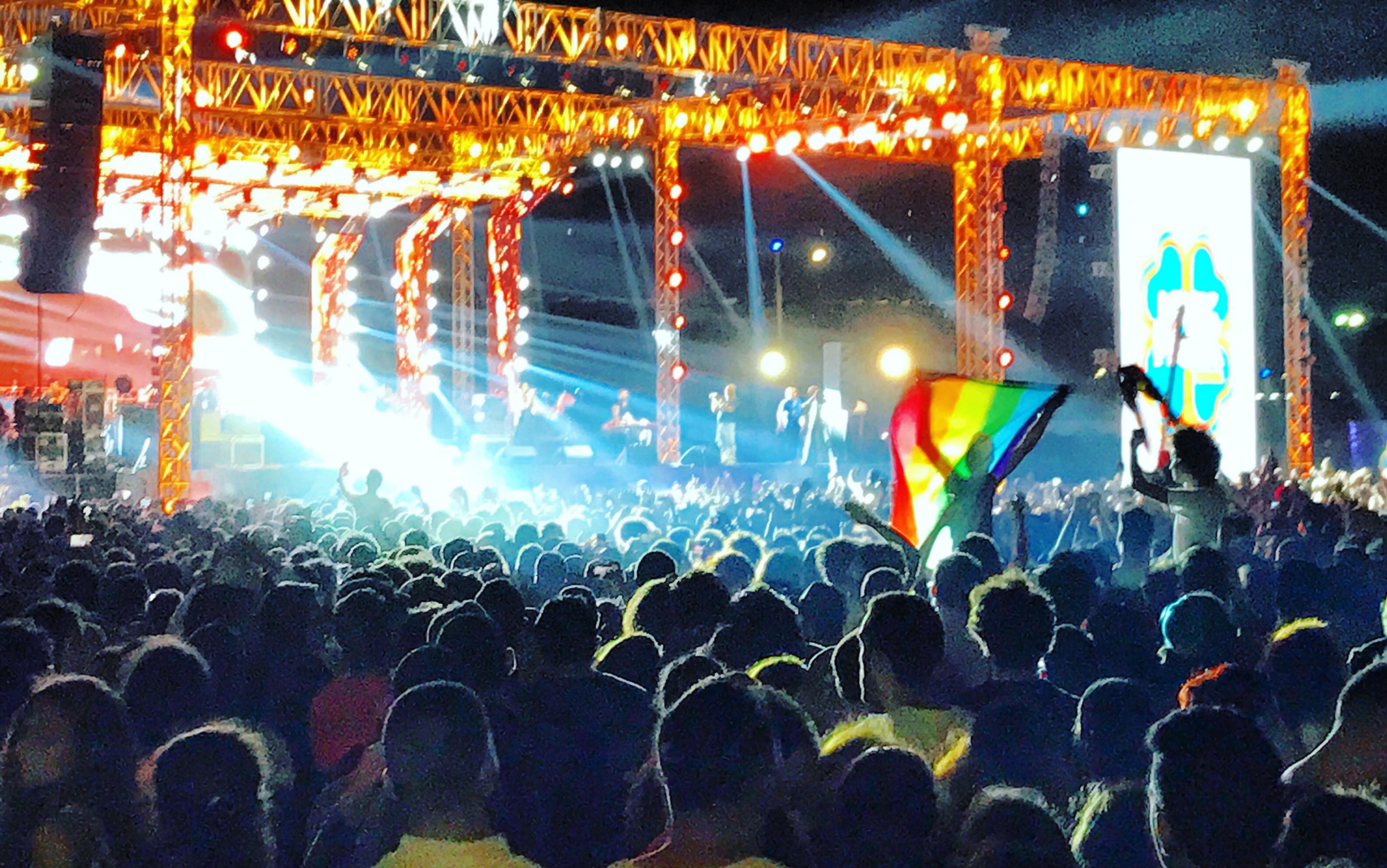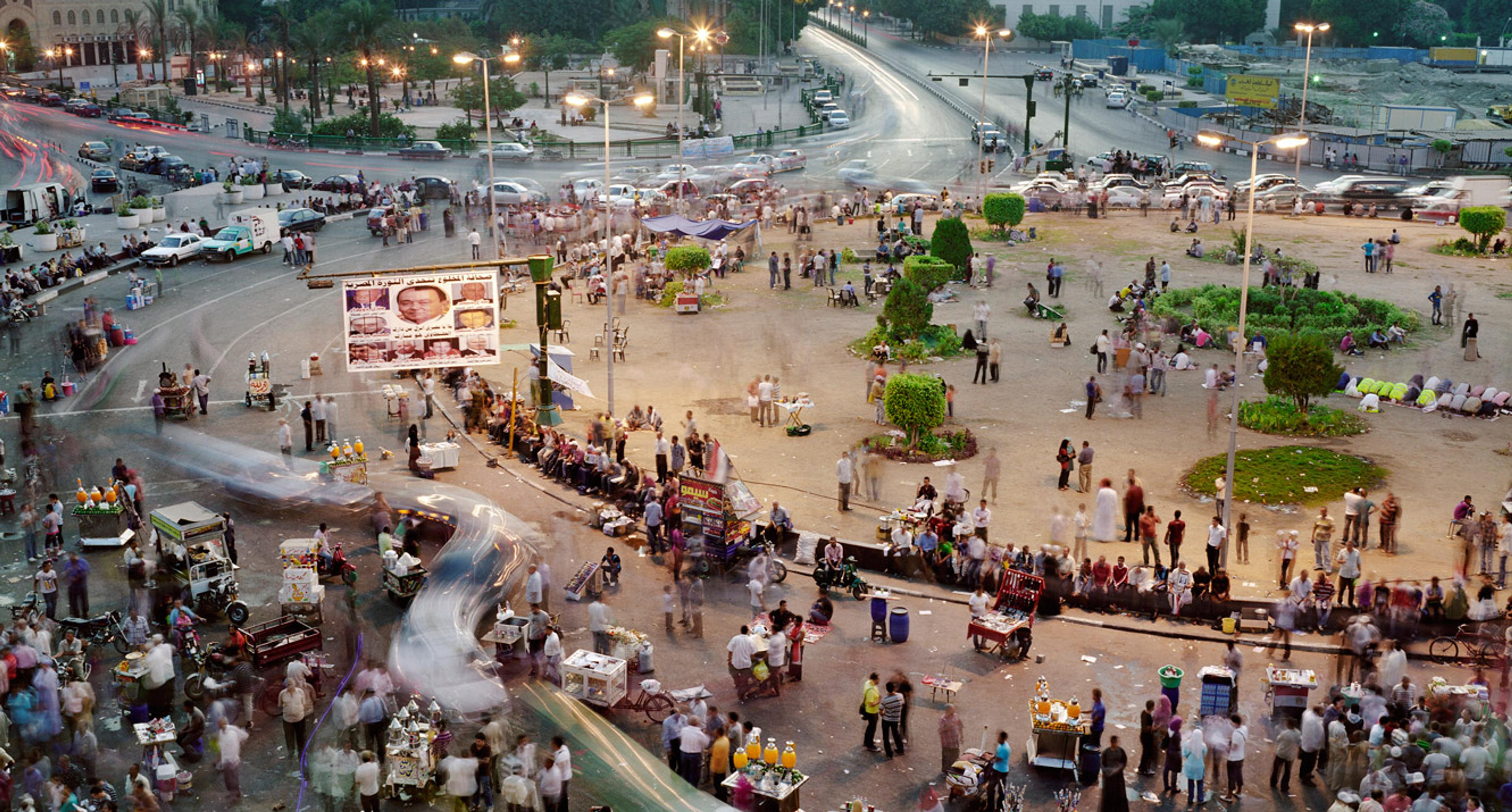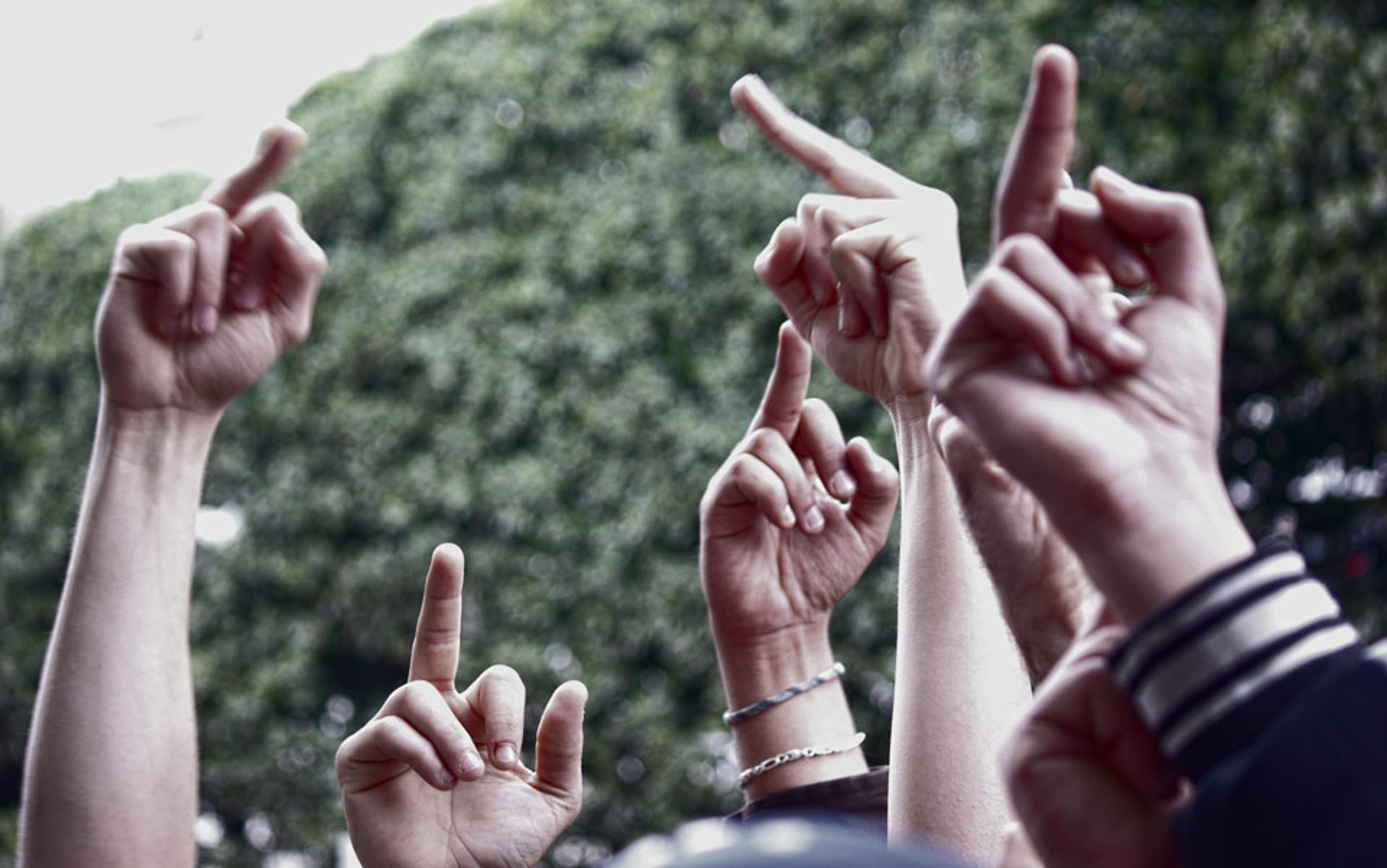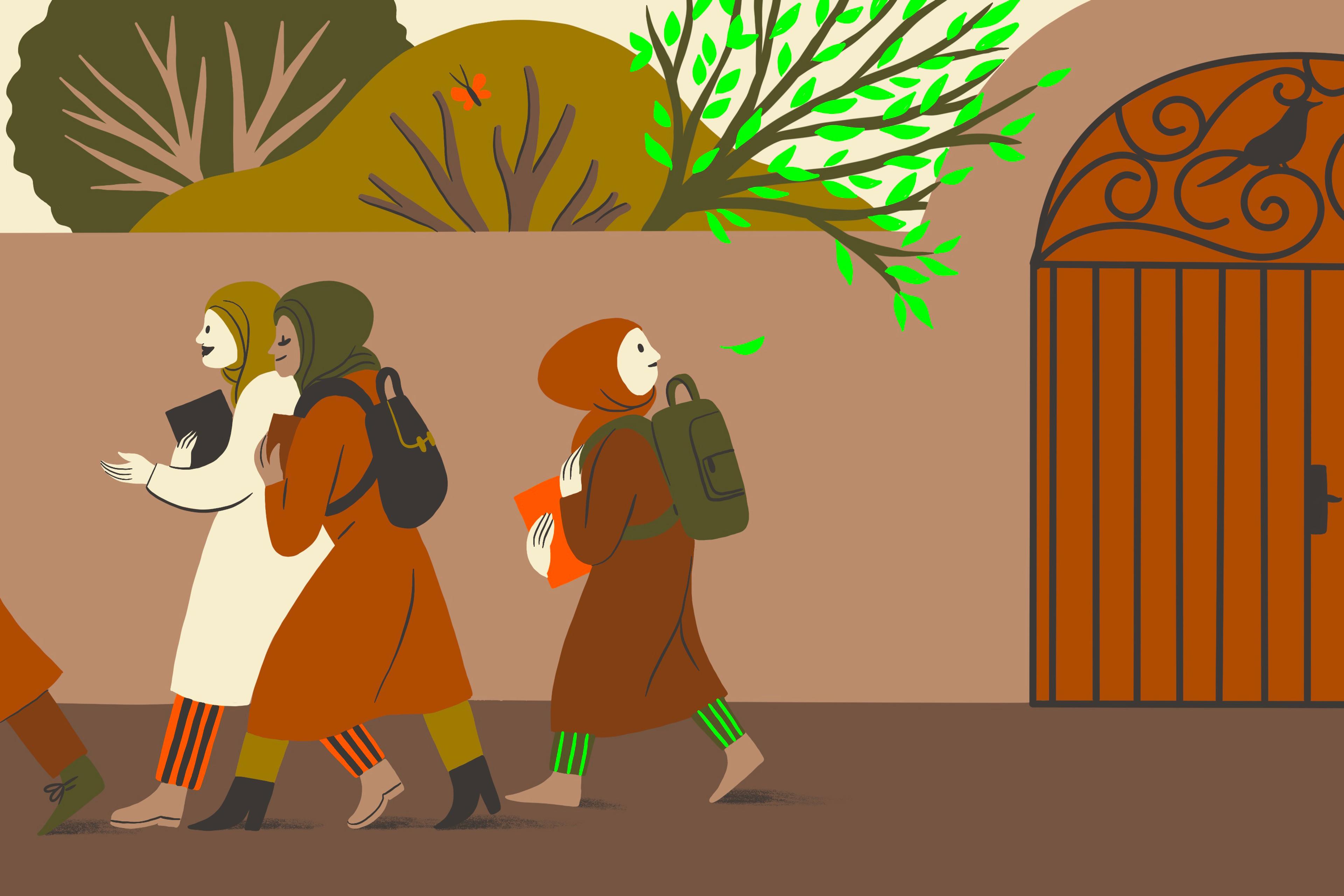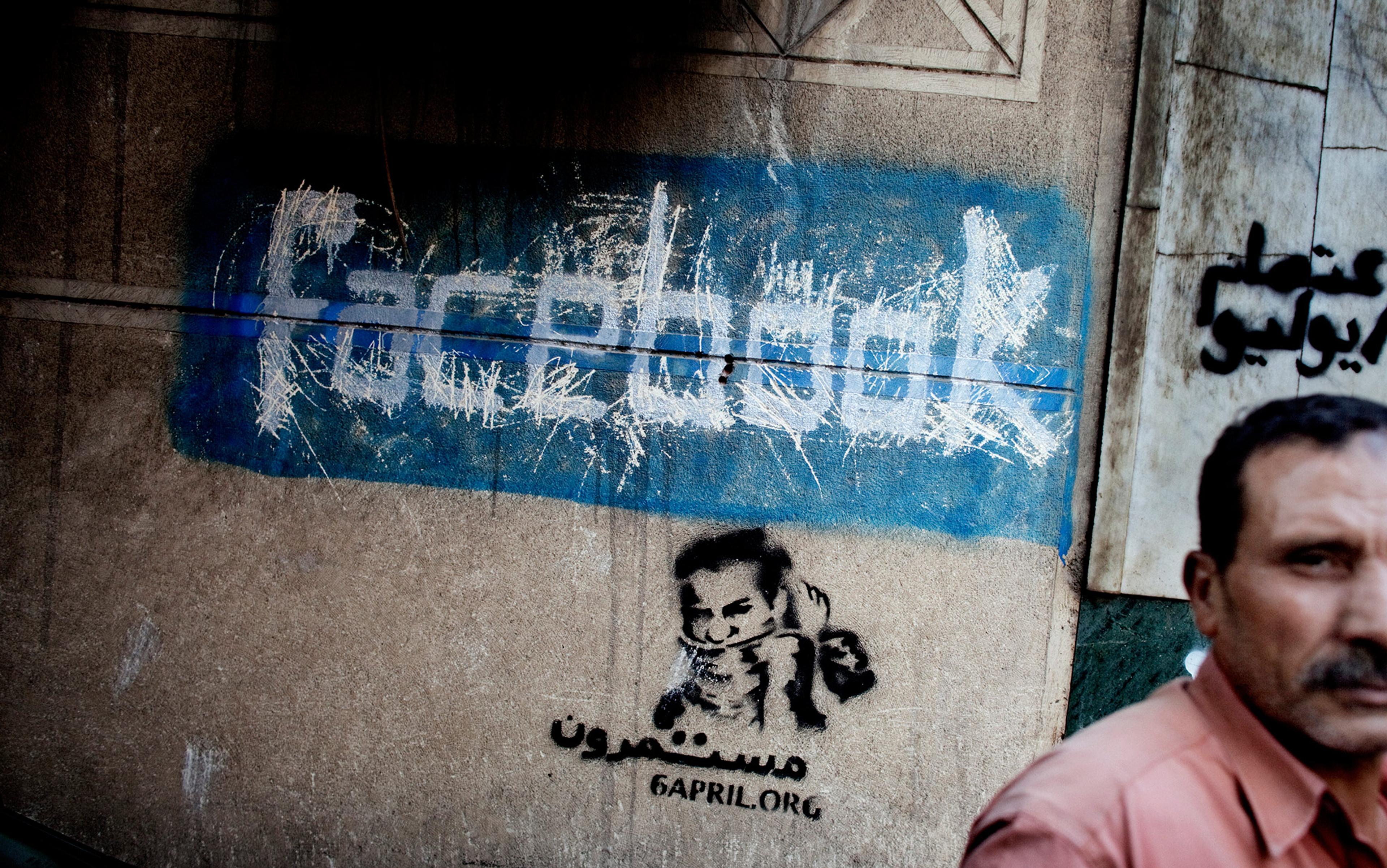The face, a nod to her Egyptian mother, is pharaonic, curls freefalling all around it. The muscles packing her body betray countless hours of toil in the pool, on the bench press, on her feet — running. Her attire is as blunt in its skimpiness as Jordan, where she lives, is adamant in its conservatism. But while the look screams a fight easily won, her demeanor is tactful, her tenor even-keeled. This is a woman used to negotiating her way through life.
I will call her Hadaf, a common enough Arabic name, befitting a woman whose 34 years have been just that: hadaf, meaning singular purpose. At first glance, neither her impressive résumé nor her place in Jordanian society surprise. The milestones are all there: a BA in graphic design from Yarmouk University, up north in Irbid; a stint with a successful advertising agency, followed by a top executive job in a global company; and, just recently, an MBA from the London Business School. In Jordan, among the well-heeled, an education and a career with the tight skirts to match are not unusual.
Get to know Hadaf a little better, though, and you uncover a life that encapsulates the hard-going, incessant, yet finally successful struggles of Arab women to transform their unforgiving circumstances into a better set of odds.
Hadaf’s Palestinian father and Egyptian mother met in Egypt in the late 1960s. She was studying interior design, he agricultural engineering. Like thousands of Palestinians looking for a living, and indeed a home, he moved to Kuwait to teach. Hadaf’s mother soon followed, becoming a teacher herself so as to tiptoe neatly around her husband’s ego; interior design, they both knew, would have made them better money, but it would have made him feel less of a man.
I escaped marriage to that mechanic by parading in a T-shirt in front of his shop. He was the one to break off the engagement
When Saddam Hussein invaded Kuwait in 1990 and Yasser Arafat took his side, many Palestinians found themselves no longer welcome in the Gulf emirate, and so they moved to Jordan to try to reconstitute a decent life. Hadaf’s father was among them. Settling on the outskirts of the capital, he started up a spare-parts business, but it failed even before it had built up steam, plunging the entire family into near poverty.
There is no equivalent dramatic moment when Hadaf’s own battles began. No epiphanies that made her want to reach for something different. Her father’s tumble from middle-class status was not drastic. The neighbourhood was more ‘a social than an economic slum’ — very conservative and very comfortable with it. Her mother donned the veil when she hit 40, because that’s what women in her milieu do upon reaching the gateway to middle age. Her father stopped drinking alcohol but did not pray his way through the days. And there was love around — plenty of it. It’s just that Hadaf walked to the beat of a different drum.
‘Inch by inch. This is how I escaped marriage at 16 to a car mechanic; how I shortened the skirt and rolled up the sleeves a tiny bit; how I managed to go to Yarmouk; how I worked as a waitress there, and at the Hard Rock Café in Amman during the summers… I lobbied my mother, talked my father to death; had him visit the dorms, had him meet the owner of the restaurant up in Irbid, had him pick me up at 2am from the Hard Rock… But, you see, I was making a living. It was very difficult for them to argue with that.’
There were, of course, many fudges, omissions and fibs. ‘I did not tell my parents that I moved into my own apartment the second year of college [and] I escaped marriage to that mechanic by parading in a T-shirt in front of his shop. He was the one to break off the engagement. All I had to do then was persuade my father to let me finish high school.’
When Hadaf started to win the family’s bread, as it were, the parents went quiet. And they’ve been quiet ever since. Yet, even now, for their sake, Hadaf says, ‘I have two wardrobes at home: one for me, for my life; and one for them, when I go visiting.’
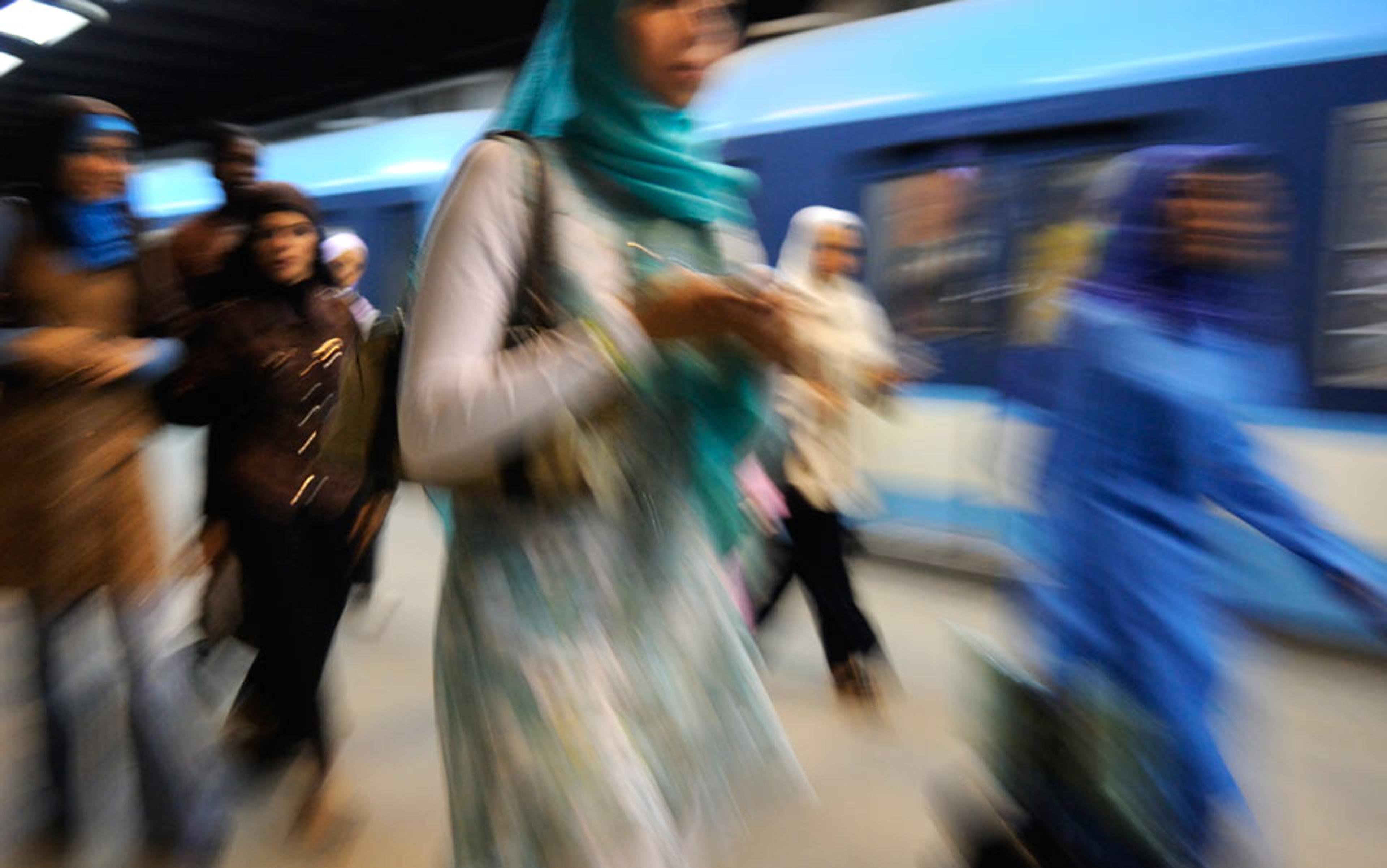
A movement without movement: women at the metro station in Cairo. Photo by Mark Henly/Panos
The Hadafs of the Arab world outnumber women like me, for whom life has been much gentler. But we don’t strain to reach out for each other across the divides. I did not have to go in search of her for insight. She lives everywhere around me. Hadaf populates the Middle East.
That said, hers is a distinctly upbeat story. Other women are fighting tooth and nail for much smaller breaks. They do win in the end — inch by inch — but the toll tends to draw age early on a young face, and the demands on grit and courage are almost always insufferably unkind.
A 22-year-old Palestinian – I’ll call her Suad – works with me on a region-wide community development initiative. She has just set aside her veil in conservative surroundings. She describes her own and her female friends’ lives in Beirut as an incessant search for opportunity amid a heap of constraints. ‘You worry about the consequences, and then you take a step, and then another one after that, and another one after that… You make use of every opening.’
This particular step, her unveiling, has proven to be especially charged. Suad took up the veil, a blend of shapes and colours in her case, at the age of 17, the last in her class to do so. Although most of her school friends were veiled, her parents’ leftist inclinations helped check the growing calls for Suad to amass herself into the fold. It was her teacher’s warning that finally tipped the scales. ‘She brought me before the entire class and told me that my mother would go to hell if I did not wear it. I succumbed.’
Suad took off her hijab two months ago, inspired by the rousing theme of nonconformity threading through her English literature courses. She felt she was being true to her identity.
Yet reactions to her move in a milieu that actively discourages feminine unorthodoxies are mixed. Suad’s father is happy to see her let her hair down and so, she thinks, would have been her mother, had she lived to witness this pointed return to visibility. So far, however, the neighbourhood has been worryingly quiet; and the backlash at work, especially among the men, upsetting. In the midst of widespread opprobrium, only one friend has said: ‘If that’s what you want, then do it.’ Suad shrugs. ‘Better this than hypocrisy.’
On their own, such triumphs as Suad’s and Hadaf’s stand as little more than heartening anecdotes on the margins of what is a crushingly discouraging situation for Arab women. One is tempted to ask: only this, after so many years of struggle? But pulled together and read differently, these small victories create a different norm of empowerment — one that, paradoxically, draws strength from the very subtlety and everyday nature of the ‘dissident’ acts themselves.
Asef Bayat, an authority on Islamism and professor of sociology and Middle Eastern studies at the University of Illinois at Urbana-Champaign, calls this quiet dissent the ‘art of presence’. His term aptly describes the multitudes of women who, through ‘the mundane [pursuit] of education, sports, arts, music or work’, haggle over more space and better terms with deeply conservative authoritarian regimes and patriarchal societies. If their methods stand in stark contrast to the public activism typically exercised in the West, it is with good reason: they are much more effective in extricating concessions from systems that are lethally unresponsive to organised action. The path of resistance is thus a ‘non-movement’ by defenseless constituencies, massaging the possible in pervasively hostile environments.
As Islamists reap the rewards of last year’s Arab uprisings, the fear is they will overturn what little rights have accrued for women
Even during a supposedly more liberal Arab moment, decades back, women walked this same path. For the novelist Hanan al-Shaykh, Hadaf’s journey recalls episodes from her own youth in Lebanon: ‘That’s how we did it back in the 1950s and ’60s. Piecemeal. Small steps hiding big dreams. If a girl from Nabatieh [in the south] had her eyes on Beirut, she would tell her family she just wanted to go to Sidon [a bigger town than her own]. If she wanted to get a university education, she would settle for a teaching diploma or nursing.’
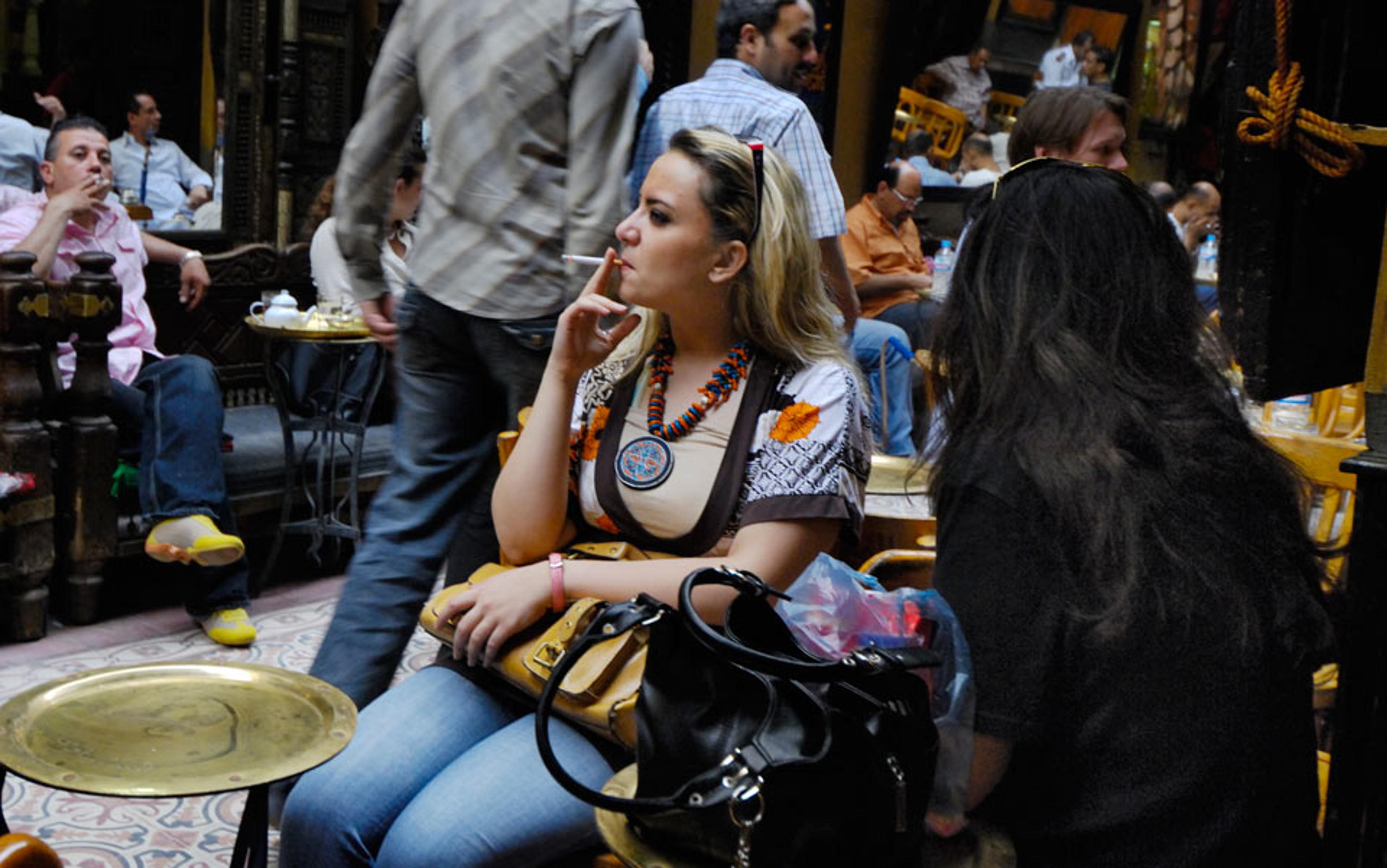
While some women adopt the hijab others take it off in a ‘pointed return to visibility’ . Photo by Mark Henley/Panos
The incrementalism of Hanan al-Shaykh’s days would shadow breakthroughs not retreats. ‘Layla Ba’albaki’s monumental novel Ana Ahya (I Live), published in 1958, tore through so many taboos,’ she tells me. ‘You could see the modern Arab woman take shape. There were pressures, but we had just started. Life was like a Chinese cupboard: one drawer for politics, one for culture, one for religion… You could be angry at the West and yet long for conversations with it.’
In the event, Hanan al-Shaykh has managed this tricky path with expert footing, for in spite of her daring writings she is still well received in many Arab countries, including those where her novels are banned.
When I look back on a century of Arab women’s struggles myself, and regardless of how many stages the experts delineate for us through a history battered by colonialism and harangued by our own aggrieved search for cultural authenticity, my sense is that our activism has always been about that art of presence.
This is not to suggest that this region has been free of concerted public advocacy for gender rights. But that too, inevitably, has had to be a rather genteel prodding of the state, carefully balancing its very masculine sensibilities with emphatic demands for better legal protections.
It is not surprising that, in these potentially revolutionary times, the prospects for Arab women seem grim. We’ve been here before. When men mobilised against colonial powers in the first half of the 20th century, women moved along with them, hoping that some of the resulting freedoms would include them. They didn’t. But then, as dictatorships quickly took root everywhere, liberation would end up offering little to the men themselves.
The fear now, as Islamists appear to be reaping the rewards of last year’s Arab uprisings, is that history will repeat itself. Even worse, that Islamism will connive to overturn what little rights have accrued for women. Yet many commentators obsessing about our dire predicament seem to be under the impression that as the winds shift radically for systems at large, so they must for the female gender. Frantically, they look for ruptures between the present and the future, when — should the pessimists win — tomorrow, for us, will be very much like the better part of today: a continuum, a plodding, patient, opportunistic negotiation for rights in a region where patriarchal prerogative is stubbornly entrenched in custom and religion, and, of course, in law.
For what does it mean, in the 21st century, that Jordanian and Lebanese women still cannot give their nationality to their children? Or that Article 308 in Jordan’s penal code saves a rapist from prosecution if he agrees to marry his victim and the marriage lasts five years? What does it mean that Article 277 in Egypt’s penal code stipulates that a man is guilty of adultery only if he commits the act at his marital home, whereas a woman is guilty regardless of where the act takes place? Or that the personal status code of the Lebanese Maronites declares a girl of 14 eligible for marriage with her guardian’s consent, 15 without?

‘You make use of every opening’: young women in Cairo. Photo by Mark Henley/Panos
Scores of women practically everywhere in the Middle East are the easy victims of honour crimes for which sentences remain the most lenient in the legal books. What does that mean?
Let me add here the veil, as a finale, and ask what it means when the hijab has become every other female’s constant companion?
With political Islam beating at the door, it is tempting to anticipate the dawn of another 1979 — the year that turned Iran upside down — with its ushering in of ‘subversive’ Shia Islamism and its wardrobe of visual props: the veil, the turban, the beard, the open hand beating against a heaving chest. But it is a bizarre temptation, with such different shades of Islamism already in full sight, from the austere Wahhabism of Saudi Arabia to the obnoxious militarist fundamentalism of Sudan, and to the Brotherhood of Hamas in Gaza.
Countries such as Jordan and Egypt might have appeared to stand firm against such headwinds. But, in truth, the wins there have been few, while the concessions to stricter interpretations of Sharia have been many, rendering family law a perversion of the civic rights embedded elsewhere in their constitutions. Only Tunisia resisted fundamentalist encroachments, remaining as conspicuously secular as it was authoritarian under both Habib Bourguiba and Zine al-Abidine Ben Ali. Which explains why there is so much post-revolutionary angst that women’s rights in Tunisia will be subject to drastic reversals.
So there is no sense, really, in trying to fashion out of a very complicated narrative a simpler, more straightforward story. Even that hijab — often flagged up, since its spirited rush through the late 1970s, as the clearest proof of our break with a presumably progressive past — can’t quite bend to stereotype, camouflaging a battle for agency that has been as hard to fight without it as it has been with it.
In this century-long grind, it would have to be the hijab, wouldn’t it, that offers up a chronicle wrapped head to toe in irony. Of course this powerful symbol would galvanise warring camps. Once shedding it was cited — tellingly enough, by both sides — as evidence that (Western) modernity was winning the argument in the (conquered) East, it was bound to be taken up again, as armour, by women in harassed societies, questing for their inner voice by way of a rebuttal.
In veiling herself, a woman seeks reprieve as well as freedom of movement — akin to closing the windows in order to keep the door open
As a matter of fact, for a sea of veiled Arab Muslim women, the veil has never been a choice — pure and simple. Equally, it has always been the happy route of those who believe they are fulfilling God’s wish — no more, no less. But when scholars went in search of explanations, they found women at the forefront of the discontent that has fuelled the veil’s ready adoption as a centerpiece of identity politics. If the relatively better educated — and, yes, more affluent — types were first to unveil in the early years of independence, soon followed by others further down the economic rung, so the daughters of the rising middle classes would be first to put it back on a few decades later, sending it up the same rung.
That Islamists, who had long been rallying to spread this star marker of their influence, grabbed a hold of the trend and ran with it was just smart strategy and brilliant timing. They plowed fertile minds and made use of every advantage in a propitious regional climate: the collapse of Gamal Abdel Nasser and his charade of secularism and Arabism in Egypt; the Gulf money that sponsored the dimmest visions of Islam almost everywhere in the East; the ripening fight against leftist currents in the region, in which religion would be the sharpest of weapons. All this passed with little comment under the watchful eyes — and often active encouragement — of our so-called Western friends.
There are lessons to be learned from Columbia University professor Lila Abu-Lughod’s reminder that ‘some of the most conservative movements that focus on women in these parts of the world have resulted from interactions with the West’.
Perhaps the most consequential of these lessons is that the insistence on context is not scapegoatism. It seems embarrassingly elementary, but easily the most unfortunate failure of thought in the debate on Arab women’s subjugation has been the race between those who conveniently locate the problem strictly within the Arab-Muslim self, and those who furiously look everywhere else for culprits. The problem, of course, is a miserable brew of both. Nor is the damage limited to the quality of the debate. For by ignoring the impact of policy on the direction of culture and politics, we risk the most wrongheaded of remedies.
With plights as fraught with pain as that of Arab women, however, context is a tricky thing. It often trespasses on comforting stereotypes and requires studied deliberation when the wounded heart thirsts for indictments of the sweeping kind.
If you listen to the arguments of the hijab’s early champions, for example, you find yourself weaving a paradox of defiance in retreat, of empowerment through conformity. The more women went about their business freely in public, the more the indignities seemed to pile up in the hustle and bustle of life in, say, 1970s Cairo. On buses, in the workplace, in the neighbourhood, at university, there boomed the loud discomforts of a society that had never quite accepted women as full partners in the public arena. Hence the merciless harassments that have turned a supposed act of emancipation into a sellout to Western corruptions.
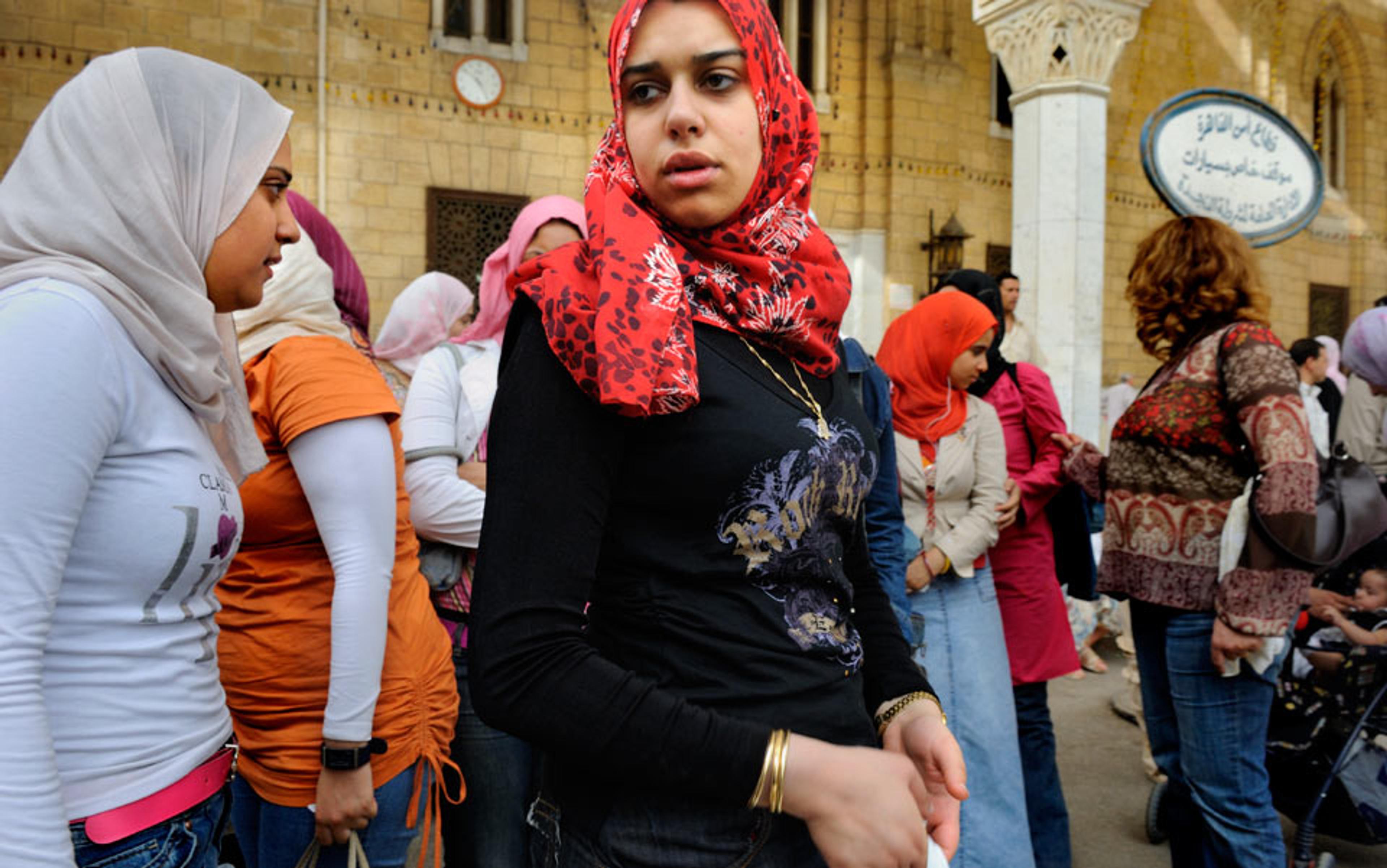
Rebellion in the guise of the surrender: the hijab is swathed in ironies. Photo by Mark Henley/Panos
The motivations that crowned the veil on many a woman’s head are various: there’s the need for a shield, for an expression of faith in one’s embattled heritage, or simply the compulsion to follow the example of others — easier to fade into the pervading scene, and to belong. In veiling herself, a woman might at once seek reprieve as well as retain some form of freedom of movement in stubbornly inhospitable climates. By consciously taking her visage out of contention, she might be allowed to carve a respectable space for herself — akin to closing the windows in order to keep the door open.
More than 30 years have passed since the veil made its comeback, but talk to women today and the stories you hear have the same complex weave. As Dina El Sherif, an Egyptian in her mid-30s, and a professional in the field of social entrepreneurship, put it to me in a moment of exasperation: ‘We [women] live in a constant state of struggle — culturally, socially, economically, politically. It’s… exhausting.’ She happened to opt out of the hijab. Others didn’t.
Surrender in the guise of rebellion? That’s always been easy to argue about the veil. But so, it needs to be said, is rebellion in the guise of surrender.
Ultimately, there is something inescapably unsatisfying about the nuance here — much like that larger one which pervades the larger issue of the repression of Arab women. For even the most sensitive reading of the veil and its many meanings cannot avoid the rueful question that Samar Dudin, a 49-year old Jordanian activist and community organiser, voiced towards the end of one of our many conversations:
Tell me, will you: what kind of a free choice is it, when you’re making it out of fear, or need of
sutra
(protection), or intolerable peer pressure, or just, for the love of God, to be left alone? How do you actually practice free choice in the absence of even a semblance of freedom? I mean, where does this kind of contamination in a supposed act of free will belong in this debate?
More than exposing the serious tensions between obligations and rights under Islamism, her question brings into sharp relief the more fundamental matter of citizenship and its requirements, specifically those that postcolonial regimes wiped clean from the lexicon of Arab politics. Opinion-makers — male and female, Eastern and Western — who attempt to disentangle the case for Arab women from the wider disquiet that triggered the uprisings do it a most grave injustice. The complaint against Islam and/or patriarchy, however appealing, is incomplete. Implicated though they might be, the more effective attack is against despotism and its local and foreign patrons who have cynically played and reinforced both, leaving targets, such as women, vulnerable to all manner of assaults.
How optimistic dare we be in our predictions about a region that is extremely susceptible to political manipulations?
It is telling that the very first tide of Arab female activism accompanied the battle against Empire, while this current one of Islamic feminism accompanies the fight against domestic tyranny. I say Islamic feminism because, predictably, as societies and polities have become more decidedly Islamic, so have, in the main, the public endeavors by and on behalf of women. That, after all, has been the path of gender rights in the Arab world from the outset: a pragmatic, incremental approach that has almost always moved with wider trends. We have been marching towards a crossroads for a while now. The Arab revolts had the unique honour of announcing it. But the forces at play have long been in the making.
We are, in fact, in the midst of heated post-Islamist arguments over a religion that has been brought down to arbitrate even the minutiae of everyday existence; between those who insist that Islam is a strict regime of unalterable duties and rituals meant to control the very rhythm of life, and those who counter that it is but a body of evolving ethics designed to guide but never govern.
It is in such arguments that the future of the Arab world lies — and, by extension, our own future as Arab Muslim women. If successful, the drive for a more participatory and expansive politics will necessarily embolden demands for human and civic rights, in which case women’s struggle will become more audacious and insistent. If it fails, then autarchy will regain momentum, and we’ll just keep plodding on.
Barely a few pages into this new era in Arab history, you could sketch it every which way you like. For every female friend who sees a magnificent opportunity I have one doubting the odds, while the news keeps churning out headlines about us that lift the spirit only to sink them again.
For Dina, the 30-something from Cairo who chose not to wear the veil and who has always been as comfortable with her faith as she is with her ‘liberal’ self, one recent experience has become a measure of how life has already begun to change. Previously, Cairo’s notorious pre-revolutionary streets had subjected her to the usual mixture of disdain and cold-shouldering. But right after the uprising, she started to experience more threatening taunts, urging her to cover up. She flinched at first, scurrying ahead to avoid contact — a rather strange reaction for the self-described offspring of ‘a family of very strong women’. But these slurs had much sharper edges than the insults of old. And then, suddenly, she decided to do her own one-woman revolt. She started to shout back.
